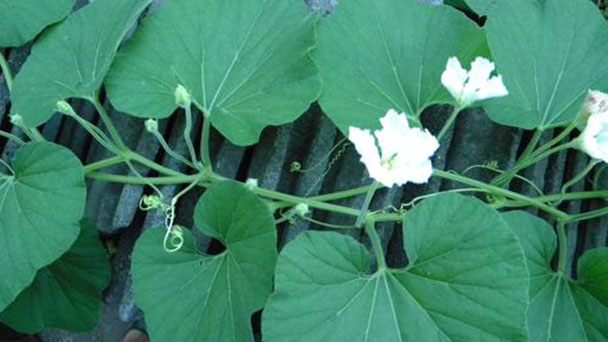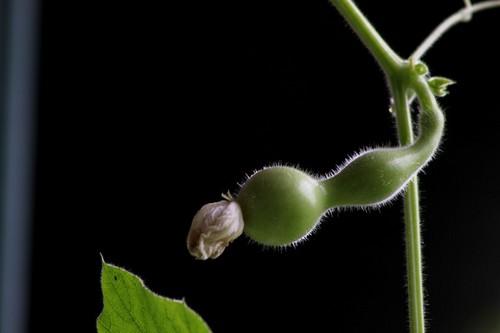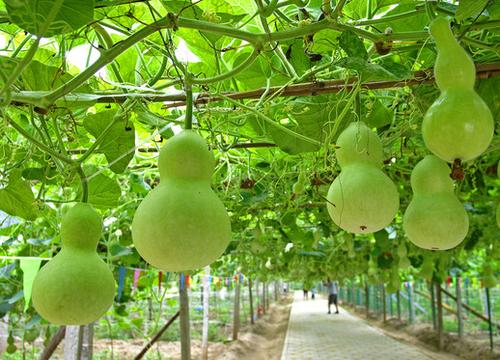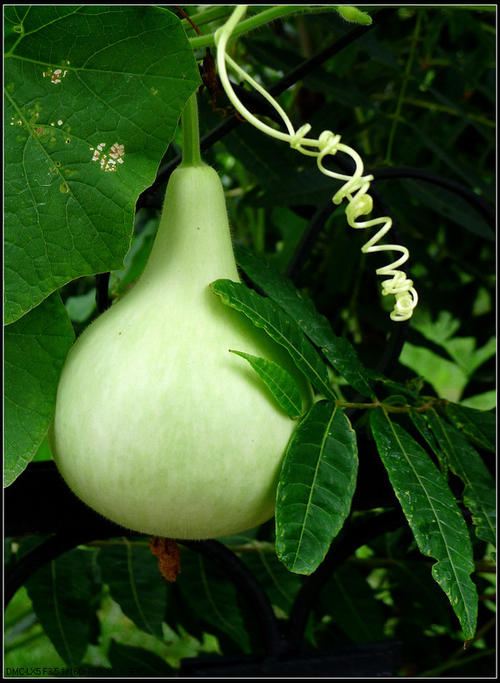Calabash (Lagenaria siceraria) profile
Written by Maggie
Mar 10 2021

Calabash, Latin scientific name: Lagenaria Siceraria (Molina) Standl. Calabash belongs to Cucurbitaceae and Cucurbitaceae plants. Calabash is a climbing vine plant, an annual climbing herb, with soft hair, white flowers in summer and autumn, and monoecious plants. Calabash vines can reach 15 meters in length, fruits can range from 10 centimeters to 1 meter, and the heaviest can reach up to 1 kilogram.
Calabash likes a warm, sheltered environment, so they need a lot of space to grow. Young plants fear the cold. The fresh Calabash skin is pale green and the flesh is white.
The length of vines, the size of leaves and flowers, and the size and shape of fruits are different in each cultivation type of calabash. The fruit is clavelike, gourd shaped, porpoise shaped, pot shaped, etc. The name of the type also depends on the fruit shape. In addition, in ancient times, people dried calabash and hollowed out its interior to make objects for storing things.
Calabash picture

Morphological characteristics of Calabash
Stem branches
Calabash (original variety) is an annual climbing herb; Stems, branches with furrows, mucky long pubescent, old gradually shed, become nearly glabrous.
Leaf
Petiole of Calabash is slender, 16-20 cm long, with hairs like the stems and branches, apical with 2 glands; Leaves are ovate-cordate or renovate-ovate, 10-35 cm long and 10-5 cm wide, not divided or 3-5 lobed, with 5-7 palmate veins, apex acute, margin irregularly toothed, base cordate, arcuate open, semicircular or suborbicular, 1-3 cm deep, 2-6 cm wide, puberulent on both surfaces, dorsal and veined more densely. Tendril of Calabash is slender, slightly pubescent at first, after gradually shedding, becoming smooth glabrous, the upper part of 2 fiducial.
Flowers
Hermaphroditic, female and male flowers of Calabash are solitary.
Male flowers: pedicels thin, slightly longer than petioles, pedicels, calyx, and corolla puberulent; Calyx tube is funnelform, ca. 2 cm long, lobes lanceolate, 5 mm long; Corolla is yellow, lobes corrugate, 3 -- 4 cm long and 2 -- 3 cm wide, apex emarginate and apically pointed, 5-veined; Calabash has 3 stamens, filaments 3 -- 4 mm long, anthers 8 -- 10 mm long, oblong, chambers flexed.
Female flower pedicels slightly shorter or subequal longer than petiole; Calyx and corolla like male flowers; Calyx tube is 2-3 mm long; Ovary is middle constriction, densely viscid villous, style stout short, stigma 3, enlarged, 2 lobed.
Fruit
Calabash fruit is green at first, after white to yellow, due to long-term cultivation, the fruit shape variation is very big, varied from different species or varieties, some dumbbell shaped, constricted among thin, lower and upper), upper is greater than the lower, dozens of cm long, some only 10 cm long (small gourd), some flat spherical, bar or structure shaped, wooden mature skin. Seeds of Calabash are white, obovate or triangular, apically truncate or 2-dentate lobed, sparsely rounded, ca. 20 mm long.
Calabash flowering in summer and fruit in autumn.
The ecological habits of Calabash
Calabash is suitable for good drainage, fertile soil and low - lying land and irrigated hilly land.Avoid watermelon and other melons to welcome stubble.

Species classification of Calabash
Vegetable marrow (variety) flat Pu
The difference with calabash (original variety) is that the ovary is cylindrical;The fruit is well balanced and cylindrical, straight or slightly curved, up to 60-80 cm long, green white, white pulp.Cultivated throughout the country, the Yangtze River Basin area is widely cultivated.When tender, the fruit is soft and juicy and can be used as a vegetable.
Small Calabash(variety)
The difference with calabash (original variety) lies in: the plant is more fruiting, the fruit shape is like calabash, but small, only about 10 cm long.China is much cultivated.
The fruit of this variety is medicinal, and the shell becomes lignified after maturity.Seed oil can be used to make soap.
Bottle Calabash (variety)
The main difference between this variety and the calabash (the original variety) is that the marrow marrow fruit is flat and spherical, about 30 cm in diameter.Cultivated everywhere.
The fruit of this variety can be used as a gourd and container;In ancient and modern times, many ethnic minorities also used it as a musical instrument, one of the "eight tones", and the southwest ethnic minorities used it as a gourd sheng or a gourd flute with a beautiful tone.
Calabash's distribution area
Calabash is cultivated all over China. Calabash is also widely cultivated in tropical to temperate regions of the world.

Latest Updated
- Benefits of Bugleweed - 7 Science-backed Health Benefits
- Bugleweed Dangers & Side Effects - Is It Poisonous?
- How to Plant Evergreen Trees - What You Should Know
- When to Plant Evergreens - Grow Guide for Evergreen Trees
- 12 Wonderful Evergreen Shrubs for Your Garden
- 12 Popular Evergreen Plants with Pictures for Beginners
- When And How To Prune A Lilac Bush Like a Pro
- How to Grow & Care for Lilac Vine (Hardenbergia Violacea)
- Japanese Lilac Tree (Syringa Reticulata) Care & Propagation Guide
- Shumard Oak Pros and Cons - What to Know
Popular Articles
- Winter maintenance of Antirrhinum Majus
- How to Grow Terminalia Mantaly Tree
- How to Grow and Care for Crossostephium Chinense
- How to grow Antirrhinum Majus in spring
- Peristeria Elata (Dove Orchid) Profile: Info & Care Guide
- Underwatered Snake Plant (Sansevieria Trifasciata) - Signs And How To Fix
- How to Care for Brazilian Jasmine Plant (Mandevilla Sanderi)
- How to Grow & Care for Graptopetalum Purple Delight in Summer
- Rosa Chinensis (China Rose): Plant Growing & Care Tips
- How to Care for Baby Sun Rose (Aptenia Cordifolia)